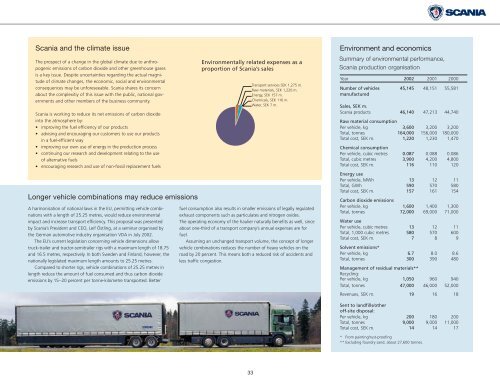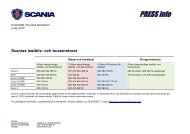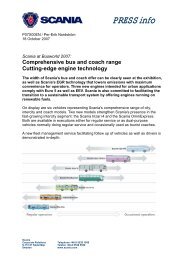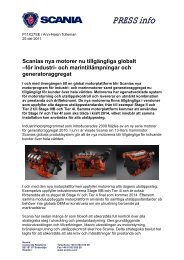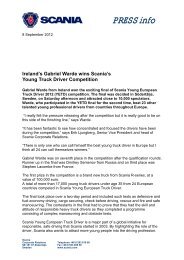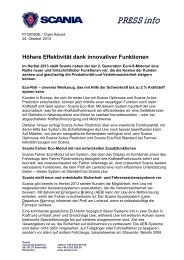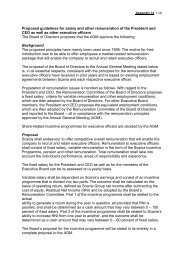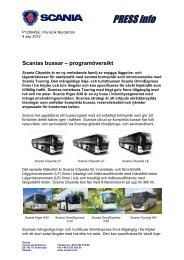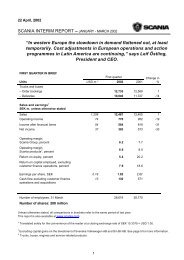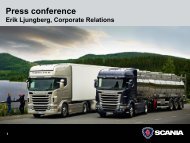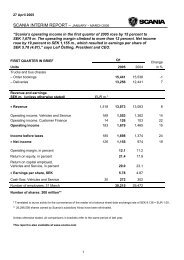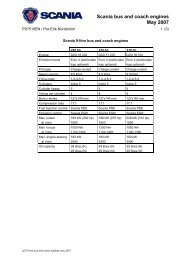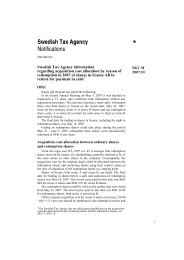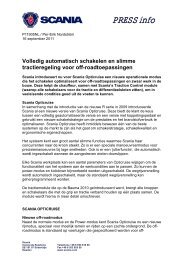Scania annual report 2002
Scania annual report 2002
Scania annual report 2002
You also want an ePaper? Increase the reach of your titles
YUMPU automatically turns print PDFs into web optimized ePapers that Google loves.
<strong>Scania</strong> and the climate issue<br />
The prospect of a change in the global climate due to anthropogenic<br />
emissions of carbon dioxide and other greenhouse gases<br />
is a key issue. Despite uncertainties regarding the actual magnitude<br />
of climate changes, the economic, social and environmental<br />
consequences may be unforeseeable. <strong>Scania</strong> shares its concern<br />
about the complexitiy of this issue with the public, national governments<br />
and other members of the business community.<br />
<strong>Scania</strong> is working to reduce its net emissions of carbon dioxide<br />
into the atmosphere by:<br />
• improving the fuel efficiency of our products<br />
• advising and encouraging our customers to use our products<br />
in a fuel-efficient way<br />
• improving our own use of energy in the production process<br />
• continuing our research and development relating to the use<br />
of alternative fuels<br />
• encouraging research and use of non-fossil replacement fuels<br />
Longer vehicle combinations may reduce emissions<br />
A harmonisation of national laws in the EU, permitting vehicle combinations<br />
with a length of 25.25 metres, would reduce environmental<br />
impact and increase transport efficiency. This proposal was presented<br />
by <strong>Scania</strong>’s President and CEO, Leif Östling, at a seminar organised by<br />
the German automotive industry organisation VDA in July <strong>2002</strong>.<br />
The EU’s current legislation concerning vehicle dimensions allow<br />
truck-trailer and tractor-semitrailer rigs with a maximum length of 18.75<br />
and 16.5 metres, respectively. In both Sweden and Finland, however, the<br />
nationally legislated maximum length amounts to 25.25 metres.<br />
Compared to shorter rigs, vehicle combinations of 25.25 metres in<br />
length reduce the amount of fuel consumed and thus carbon dioxide<br />
emissions by 15–20 percent per tonne-kilometre transported. Better<br />
Environmentally related expenses as a<br />
proportion of <strong>Scania</strong>’s sales<br />
Transport services SEK 1,275 m.<br />
Raw materials, SEK 1,220 m.<br />
Energy, SEK 157 m.<br />
Chemicals, SEK 116 m.<br />
Water, SEK 7 m.<br />
fuel consumption also results in smaller emissions of legally regulated<br />
exhaust components such as particulates and nitrogen oxides.<br />
The operating economy of the haulier naturally benefits as well, since<br />
about one-third of a transport company’s <strong>annual</strong> expenses are for<br />
fuel.<br />
Assuming an unchanged transport volume, the concept of longer<br />
vehicle combinations reduces the number of heavy vehicles on the<br />
road by 20 percent. This means both a reduced risk of accidents and<br />
less traffic congestion.<br />
Environment and economics<br />
Summary of environmental performance,<br />
<strong>Scania</strong> production organisation<br />
Year <strong>2002</strong> 2001 2000<br />
Number of vehicles 45,145 48,151 55,581<br />
manufactured<br />
Sales, SEK m.<br />
<strong>Scania</strong> products 46,140 47,213 44,740<br />
Raw material consumption<br />
Per vehicle, kg 3,600 3,200 3,200<br />
Total, tonnes 164,000 156,000 180,000<br />
Total cost, SEK m. 1,220 1,230 1,470<br />
Chemical consumption<br />
Per vehicle, cubic metres 0.087 0.088 0.086<br />
Total, cubic metres 3,900 4,200 4,800<br />
Total cost, SEK m. 116 110 120<br />
Energy use<br />
Per vehicle, MWh 13 12 11<br />
Total, GWh 590 570 580<br />
Total cost, SEK m. 157 161 154<br />
Carbon dioxide emissions<br />
Per vehicle, kg 1,600 1,400 1,300<br />
Total, tonnes 72,000 69,000 71,000<br />
Water use<br />
Per vehicle, cubic metres 13 12 11<br />
Total, 1,000 cubic metres 580 570 600<br />
Total cost, SEK m. 7 8 9<br />
Solvent emissions*<br />
Per vehicle, kg 6.7 8.0 8.6<br />
Total, tonnes 300 390 480<br />
Management of residual materials**<br />
Recycling:<br />
Per vehicle, kg 1,050 960 940<br />
Total, tonnes 47,000 46,000 52,000<br />
Revenues, SEK m. 19 16 18<br />
Sent to landfills/other<br />
off-site disposal:<br />
Per vehicle, kg 200 180 200<br />
Total, tonnes 9,000 9,000 11,000<br />
Total cost, SEK m. 14 14 17<br />
* From painting/rust-proofing<br />
** Excluding foundry sand, about 27,600 tonnes.<br />
33


